–——BASEBALL ROUNDTABLE’S BEST AND WORST ALL-TIME NICKNAMES—-
Ted Williams collected nicknames like he collected base hits – The Kid, Splendid Splinter, The Thumper, Teddy Ballgame. And, of course, there was George Herman Ruth – or Babe, The Sultan of Swat, The Great Bambino, The Big Fella and more. Today, we have the likes of Nelson “Boomstick” Cruz, Shohie “Shotime” Ohtani, “Mad Max” Scherzer and Julio”J-Rod” Rodriguez.
Nicknames have long been a part of our national pastime – some complimentary (Joe “The Yankee Clipper” DiMaggio); some less so (Fred “Bootnose” Hoffman).
In this post, Baseball Roundtable takes a look a look two nickname-based lineups – one focused on baseball’s best nicknames, the other on some of the national pastime’s worst. The selection included such factors as:
- The quality of the nickname (including its appropriateness or inappropriateness);
- The uniqueness of the nickname;
- The stature of the player who wore the moniker (Did he add to the nickname’s prominence?);
- How it was acquired;
- It’s level of acceptance and use; and
- Longevity (Is the nickname still around and recognized?)
That fifth and sixth criteria (acceptance, use and longevity) are of particular importance. For example, Sandy Koufax’ “The Left Arm of God” nickname is clever, unique and appropriate for the Hall of Famer. It was, however, not used in fan and player conversation to anywhere near the extent of say Leroy “Satchel” Paige, Frank ”Home Run” Baker or Randy “Big Unit” Johnson. Similarly, “The Capitol Punisher” was a great nickname for Frank Howard, but he was probably better known as “Hondo.”
Uniqueness also got extra points. There have been lost of Babes, Rubes, Reds and Leftys – none found here. Or take the case of red-headed Daniel Staub known pretty commonly as Rusty. The fact is, MLB has seen plenty of “Rustys,” but (ask any Canadian fan) only one “Le Grande Orange.” Le Grand Orange makes the cut, Rusty doesn’t.
I should add that the “awarding” and general use of nicknames (among MLB players and fans) has faded a bit over time – becoming less frequent (and, I might note, less cruel) – a fact that readers will find reflected in these lineups.
Let’s get to the lists, leading off with some of MLB’s worst nicknames – often cruel, but always descriptive and almost always entertaining.
—-BASEBALL’S WORST NICKNAMES LINEUP—-
CATCHER
Gabby “Old Tomato Face” Hartnett … The Hall of Fame catcher reportedly picked up his nickname as he gained weight and developed a ruddy complexion. (There’s that “cruel” I referred to earlier.) Notably, even “Gabby” was a nickname (real name Charles Leo Hartnett) – reflecting Hartnett’s career-long shyness and reluctance to speak to anyone, particularly reporters. Harnett played 20 MLB seasons (1922-41, all but the last season with the Cubs), hitting .297, with 236 home runs and 1,179 RBI. He was a six-time All Star and the 1935 NL MVP.
Reserve: Fred “Bootnose” Hoffman … Hoffman reportedly acquired his nickname after a home plate collision between a base runner’s knee and Hoffman’s nose. Hoffman played nine MLB seasons (1919-25, 1927-28 … Yankees, Red Sox), hitting .247-7-96 in 378 games. His best campaign came as a Yankee in 1923, when he went .290-3-25 in career-high 72 contests.
FIRST BASE
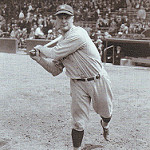
Photo by rchdj10 
Lou “Biscuit Pants” Gehrig … Great player with multiple nicknames –ranging from Biscuit Pants on the low end to Buster in the middle to The Iron Horse on the high side. The Biscuit Pants monitor – used by fellow players – acknowledged Gehrig’s baggy uniform pants, thick legs and sturdy derriere. A Hall of Famer, Gehrig played 17 seasons with the Yankees (1923-39), producing a .340 career average, with 493 home runs, 1,995 RBI and 1,888 runs scored. He was a seven-time All Star, two-time AL MVP, won one batting, title, led the AL in home runs three times, RBI five times, runs scored four times, doubles three times and triples once.
Reserve: Dick “Dr. Strangeglove” Stuart … Points for cleverness here, playing off the Dr. Strangelove movie title. Appropriateness points here, as Stuart led his league’s first basemen in errors in seven of his ten MLB seasons. He played in the majors from 1958-1966 and in 1969 (primarily with the Pirates), hitting .264-228-743.
SECOND BASE
Charlie “Piano Legs” Hickman … At 5’9” and described a north of 200-pounds (listed at 185 in Baseball Reference), it’s easy to imagine the source of Hickman’s nickname. Hickman played 1B, 2B and OF during his 12-year MLB career (1897-1908), delivering a .295 career average, with 59 home runs and 614 RBI. Hickman led the AL in hits and total bases in 1902, when he split time between Boston and Cleveland. He went ..361-11-110 that season.
THIRD BASE
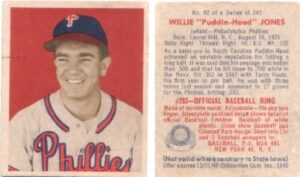 Willie “Puddin’ Head Jones … Willie Jones’ nickname (Puddin’ Head) preceded his rise to the major leagues. He picked it up as a youngster, based on a popular 1930’s song titled “Wooden Head, Puddin’ Head Jones.” And it stuck.
Willie “Puddin’ Head Jones … Willie Jones’ nickname (Puddin’ Head) preceded his rise to the major leagues. He picked it up as a youngster, based on a popular 1930’s song titled “Wooden Head, Puddin’ Head Jones.” And it stuck.
How much staying power did Puddin’ Head Jones’ nickname have? When the Phillies’ Bryson Stott opened the 2023 season with a franchise record-tying 16-game hitting streak, the NBC Sports headline began “Bryson Stott ties Puddin’ Head Jones’ Phillies record …” Then, when Stott topped Jones’ record by hitting in his 17th straight game to open the season, MLB.com headlined the story “Stott tops Puddin’ Head for Phils-record hit streak.’” Going through life, a major-league career (and beyond) known as Puddin’ Head” qualifies Jones for this spot.
Jones played 15 MLB seasons (1947-61 … Phillies, Indians, Reds) hitting .258-190-812. He was a fine defender at the hot corner and a two-time All Star. Consider: Jones led his league’s third basemen in putouts seven times, assists twice, double plays twice and fielding percentage six times. His best season at the plate was in 1951 (Phillies), when he went .285-22-81 in 148 games.
Reserve: Ron “The Penguin” Cey … Ron Cey reportedly picked up his nickname in college – based on his running style. Cey played in 17 MLB seasons (1971-87), primarily for the Dodgers. He was a six-time All Star and had a career stat line of .261-316-1,139. Cey hit 20+ home suns in ten season. I also considered Gary “The Rat” Gaetti, but he lost a few points because he was also known as “The G-Man” – a much more complimentary moniker.
SHORT STOP
Bill “Wagon Tongue” Keister … Unlike Gabby Hartnett (see the catcher on this list), Bill Keister reportedly just wouldn’t shut up. In a seven-season MLB career (1896, 1898-1903), Keister played for Brooklyn, Boston, Saint Louis and Philadelphia in the NL and Baltimore and Washington in the AL. He hit .312, with 18 home runs, 400 RBI and 131 stolen bases – spending time at shortstop, third base and second base. In 1901, he set the all-time MLB low for fielding average by a shortstop (.851) – making 97 errors in 112 games (650 total chances).
Reserve: Leo “The Lip” Durocher … A fiery player (and later equally scrappy as a manager), Leo Durocher earned his nickname as a particular loud and aggressive “bench jockey.” The spirit in which the nickname was applied depended on which bench you were on. A Hall of Famer, Durocher played in 17 MLB seasons (1925, 1928-41, 1943, 1945), hitting .247-24-567. He was an MLB manager for 24 years. Could have been the starter on this squad, but “Wagon Tongue” is just more unique than “The Lip.”
Branch Rickey on Leo Durocher
“He had the ability of taking a bad situations and making it immediately worse.”
LEFT FIELD
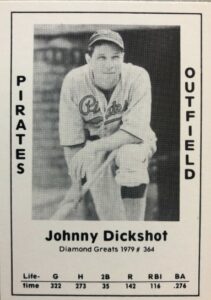 Johnny “Ugly” Dickshot … Apparently not the best looking of men, it’s reported that Dickshot granted himself the title of the ugliest man in baseball. Clearly, the combination of his nickname and actual name earns Dickshot a spot on this list of worst baseball nicknames. In six major-league seasons (spread over 1936-45), he played in 322 games (Pirates, Giants, White Sox), hitting .276, with seven home runs and 116 RBI. More than half his career offensive production came in his final season (1945, White Sox), when he hit .302, with seven home runs and 58 RBI.
Johnny “Ugly” Dickshot … Apparently not the best looking of men, it’s reported that Dickshot granted himself the title of the ugliest man in baseball. Clearly, the combination of his nickname and actual name earns Dickshot a spot on this list of worst baseball nicknames. In six major-league seasons (spread over 1936-45), he played in 322 games (Pirates, Giants, White Sox), hitting .276, with seven home runs and 116 RBI. More than half his career offensive production came in his final season (1945, White Sox), when he hit .302, with seven home runs and 58 RBI.
Reserve: Bris “The Human Eyeball” Lord … Okay, this was meant as a compliment, but its imagery qualify it for a reserve spot on the Roundtable’s worst nickname lineup. Lord was tabbed the “Human Eyeball,” because he was said to enjoy superior eyesight. However, a look at the record shows that, in an eight-season MLB career (1905-1907 and 1909-1913), he hit just .256 and struck out nearly twice as many times as he walked (342-175). Lord did enjoy a stellar season in 1911, when he went .310-3-55, with 15 steals for the Athletics. It was the only season in which he hit at least .270.
CENTER FIELD
Hunter “Captain Underpants” Pence … Okay, this one has not been used to the extent of many of the nicknames on this list – but it’s cleverness (wordplay) swayed me. The story has it that, during a minor-league game, an aggressive heckler thought that (on the minor-league PA system) “Hunter Pence” sounded a lot like “Underpants” and proceeded to taunt him with the Underpants chant, which apparently gained more staying power when teammates promoted Mr. Underpants to “Captain.” Pence played in 14 MLB seasons, 2007-2020, hitting .279-244-942. He was a three-time All Star.
Reserve: Norman “Turkey” Stearnes … Stearnes was no turkey. He was a five-tool, five-time Negro League All Star, whose nickname reflected the way he flapped is arms while running the bases. He played 18 MLB seasons (1923-40 … Detroit Stars, Chicago American Giants, Philadelphia Stars, Kansas City Monarchs). Over that time, Stearnes hit .348 (winning two batting titles), with 187 home runs and 1,009 RBI (993 games). He led his league in triples six times, home runs five times, doubles once, and hits once, He may have run like a turkey, but he played like a Hall of Famer (he was inducted 2000). Still, Turkey is not the most complimentary of nicknames, unless you are a bowler.
RIGHT FIELD
“Bucketfoot” Al Simmons … Another Hall of Famer on this list, Simmons’ nickname (which he disliked) was drawn from his batting stance. The Bucketfoot stance seemed to work for him. In 20 MLB seasons (1924-41, 1943-44 … Athletics, White Sox, Tigers, Senators, Braves, Reds, Red Sox), Simmons hit .334, with 307 home runs and 1,828 RBI. He led his league in batting average, hits and total bases twice each and RBI once.
Reserve: Walt “No Neck” Williams … Walt Williams was just 5’6” tall, with a stocky build and a short neck (said to be the result of a childhood medical issue related to a typhus injection.) Despite his stature, Williams enjoyed a ten-season MLB career (1964, 1967-75 … Astros, White Sox, Indians, Yankees), during which he hit .270-33-173. William was known as a high-energy, free swinging, always aggressive ballplayer. How well-known was his nickname? His New York Times obituary was headed “Wal Williams, Outfielder Known as No Neck, Dies at 72.”
STARTING PITCHER
Hugh “Losing Pitcher” Mulcahy … Ouch! Hugh Mulcahy “enjoyed” a nine-season major-league career (1935-47, minus five WWII years), during which he earned his nickname. He ran up a career record of 45-89, with a 4.49 ERA (all with the Phillies), leading the NL in losses twice, hits allowed once, earned runs allowed twice, walks allowed once, hit batsmen twice and wild pitches once. Notably, he made one MLB All Star squad; in 1944, when he led the NL with 22 losses (versus 13 wins), despite a respectable 3.60 ERA.
Reserve: Arthur “Rats” Henderson … A nickname that evokes such rodents is a pretty sure path to this list. For Arthur “Rats” Henderson – who pitched in the Negro Leagues from 1923-31 – the way he reportedly acquired the nickname, earned him extra credit. It seems, before his MLB days, while working at a glass factory, fellow employees placed a rat in his lunchbox (much to his surprise and terror when he opened it.) Henderson, known for a sharp-breaking curve and superior fastball, went 70-51, 3.61 over eight seasons with the Atlantic City Bacharach, St. Louis Stars and Detroit Stars.
CLOSER
Mitch “Wild Thing” Williams … Not a lot of bad nicknames for closers. Who wouldn’t want to be called Terminator, The Fireman or even Monster. The best I could come up with was Mitch “Wild Thing” Williams – simply because of the implication of being a little wild (in relation to the strike zone) – when called on to close out an opponent. Williams’ nickname is due in part to pop culture (think Charlie Sheen’s Ricky Vaughn in the movie Major League), but also reflects Williams’ more than occasional lack of familiarity with the strike zone and a particularly “wild” and off-balance delivery.
Over an 11-season MLB career (1986-95, 1997), Williams was “effectively wild.” He went 45-58, 3.65, with 192 saves (from 1988-93, he averaged 29 saves per season). Over his career, he also averaged 7.1 walks per nine innings.
Walkway to Success
In 1993, with the Phillies, Mitch Williams went 3-7, 3.34, with 43 saves. He fanned 8.7 batter per nine innings and walked 6.4 per nine.
So, there is BBRT’s worst nickname lineup. If I had a a few more spots, they would probably be manned by such notables as: Jeff “Penitentiary Face” Leonard; Ernie “Schnozz” Lombardi; Harry “Stinky” Davis; and Oscar ‘Heavy” Johnson
A Couple of Sad Nicknames
“Sad” seem like a sad nickname. There have, in fact, been two MLB pitchers known popularly as “Sad” Sam Jones – and both, happily, have an MLB no-hitter to their credit.
The first “Sad Sam” Jones pitched in the major leagues for 22 seasons (1914-35 … Indians, White Sox, Red Sox, Yankees, Browns, Senators). He ran up a 229-217, 3.84 record and twice won 20+ games in a season. On September 4, 1923, he pitched a no-hitter, as his Yankees topped the Athletics 2-0 in Philadelphia. The only batter reached on a walk.
The second “Sad Sam” Jones’ MLB career included the years 1947-48, 1951-52 and 1955-54. He was a two-time All Star and put up a career 103-104, 2.83 record. This Sad Sam pitched for the Cleveland Buckeyes, Cleveland Indians, Chicago Cubs, St. Louis Cardinals, San Francisco Giants, Detroit Tigers and Baltimore Orioles. In 1959, with the Giants, he led the NL in wins (21 versus 15 losses), ERA (2.83) and shutouts (four). He led his league in strikeouts three times.
On May 12, 1955, this Sad Sam pitched a no-hitter at Wrigley field, as his Cubs topped the Pirates 4-0. In the outing Jones walked seven and fanned six.
Side Note: This Sad Sam Jones was also known as “Toothpick” Jones, but I’m giving precedence to the “Sad” nickname, since his tombstone reads “Jones … ‘Sad Sam” 1925-71.”
—–BEST BASEBALL NICKNAMES LINEUP—-
Now, here’s The Roundtable’s lineup, again based on a very subjective judgment, of the best baseball nicknames. As you will note, solid performance often results in a solid (and memorable) nickname.
CATCHER
 Ted “ Double Duty” Radcliffe … Like a few others on this list Ted “Double Duty” Radcliffe was better known by is nickname than his given name. The Double Duty moniker comes from his accomplishments as a two-way player (pitcher and catcher) – his ability to catch a full nine innings in Game One of a doubleheader and come back and pitch a complete game in the second contest. Radcliffe played in 16 MLB seasons (1928-31, 1933-35, 1937-39 and 1941-46 … Detroit Stars, Chicago American Giants, Saint Louis Stars, Homestead Grays, Columbus Blue Birds, Brooklyn Eagles, Cincinnati Tigers, Memphis Red Sox, Kansas City Monarchs, Birmingham Black Barons). He played 285 games at catcher and 89 on the mound. (In 1930, he caught 55 games and pitched 20.) Radcliffe was an eight-time All Star. He career stat line was .271-17-187 at the plate and 31-23, 3.63 on the mound.
Ted “ Double Duty” Radcliffe … Like a few others on this list Ted “Double Duty” Radcliffe was better known by is nickname than his given name. The Double Duty moniker comes from his accomplishments as a two-way player (pitcher and catcher) – his ability to catch a full nine innings in Game One of a doubleheader and come back and pitch a complete game in the second contest. Radcliffe played in 16 MLB seasons (1928-31, 1933-35, 1937-39 and 1941-46 … Detroit Stars, Chicago American Giants, Saint Louis Stars, Homestead Grays, Columbus Blue Birds, Brooklyn Eagles, Cincinnati Tigers, Memphis Red Sox, Kansas City Monarchs, Birmingham Black Barons). He played 285 games at catcher and 89 on the mound. (In 1930, he caught 55 games and pitched 20.) Radcliffe was an eight-time All Star. He career stat line was .271-17-187 at the plate and 31-23, 3.63 on the mound.
Ted “Double Duty” Radcliffe’s full name was very presidential – Theodore Roosevelt Radcliffe.
Reserve: Johnny “Little General” Bench … Catchers are supposed to take charge on the field and this nickname fits Hall of Famer Johnny Bench both behind and at the plate. Bench was a leader for the Reds for 17 seasons (1967-83). He was a 14-time All Star, ten-time Gold Glover, two-time league HR leader, two-time league MVP, 1968 Rookie of the Year and 1976 World Series MVP.
FIRST BASE

BIG HURT Photo: Frank_Thomas_1997.jpg: clare_and_benderivative work: User:Delaywaves, CC BY-SA 2.0 <https://creativecommons.org/licenses/by-sa/2.0>, via Wikimedia Commons
Frank “The Big Hurt” Thomas … When you are 6’5” and 240-pounds and can put a world of hurt on a baseball, the Big Hurt seems an appropriate nickname. Hall of Famer Frank Thomas played 19 MLB seasons (1990-2008 … primarily for the White Sox, with brief late-career stops in Oakland and Toronto). Thomas was five-time All Star and two-time AL MVP. His career stat line says a lot about the hurt he inflicted on AL pitchers – .301-521, 1,704 in 2,322 games.
Reserve Tie: Lou “Iron Horse” Gehrig … Hall of Fame slugger Lou Gehrig (see his career achievements in the worst nickname lineup under Biscuit Pants) earned this nickname for his combination of power and durability.
Reserve Tie: Albert “La Maquina” (The Machine) Pujols … Known more among fellow players than among fans as La Maquina, Pujols was machine-like in his ability to produce season after season of consistent excellence. From 2001 through 2010 – his first ten MLB seasons – he hit over .300, smacked 30+ home runs and drove in 100+ runs in every campaign. Pujols played in 22 MLB seasons (2001-2022 … primarily for the Cardinals and Angels), going .296 (3,384 hits)-703-2,218. He was an 11-time All Star, three-time MVP.
SECOND BASE
Felix “The Cat” Millan … The Cat earned his nickname for his slick fielding around the keystone sack. (Oh, and there was that cartoon.) In 12 MLB seasons (1966-77, with the Braves and Mets), Millan was a three-time All Star and two-time Gold Glover. He put up respectable offensive numbers with a career line of .279-22-403, with 699 runs scored,
Reserve: Charlie “The Mechanical Man” Gehringer … Like 1B reserve Albert Pujols, Gehringer’s teammates and opponents appreciated his almost mechanical consistency on the field. The Hall of Famer played from 1925-1942, all 19 seasons for the Tigers. His career stat line was .320-184, 1,427. He led AL second baseman in assists seven times, putouts three times, double plays four times and fielding percentage seven times. A six-time All Star, Gehringer was the 1937 AL MVP.
THIRD BASE
Frank “Home Run” Baker … Okay, can there be a better baseball nickname then “Home Run” (if you earn it)? Frank “Home Run” Baker laid the foundation for his nickname when, in his third full MLB season (1911. Philadelphia Athletics), he led the AL in home runs with 11 (It was the Deadball Era). He then built on that foundation with two critical home runs in the 1922 World Series (off future Hall of Famers Rube Marquard and Christy Mathewson), helping the Athletics top the Giants four games-to-two.
Baker further solidified his grasp on the nickname by leading the AL in home runs in 1912, 1913 and 1914. His final stat line .307-96-991 in 13 seasons (1908-14, 1916-19, 1920-21). Today, more than a century later, the average fan will immediately place the words “Home Run” between “Frank” and “Baker.”
Reserve: Pete “Charlie Hustle” Rose … BBRT could have put the ultimate hustler in at nearly any place on the diamond, but I like his aggressive play at the hot corner – where Rose started 627 games in his career. MLB’s all-time hits leader (4,256), Rose played 24 seasons in the majors (1963-86) – with the Reds (19), Phillies and Expos. Known for his hustle and aggressive play, Rose was a 17-time All Star, three-time batting champion and two-time Gold Glover, as well as the 1963 NL Rookie of the Year and 1973 NL MVP. He led the NL in games played five times, hits seven times, double five times and runs scored four times.
I also considered Brooks “The Hoover” Robinson … What can you say, a 16-time Gold Glover at the hot corner deserves to be called The Hoover. I also really like Pablo “Kung Fu Panda” Sandoval. At 5’11” and 250 pounds, Sandoval was given the Panda nickname by teammates (after a cartoon movie character) and it became a hit with fans.
SHORTSTOP
Ozzie “The Wizard of Oz” Smith … In his 19 MLB seasons (1978-96, with the Padres and Cardinals), Hall of Famer Smith’s defensive wizardry earned him 13 Gold Gloves. The 15-time All Star had a career average of .262, with 28 home runs, 793 RBI, and 1,257 runs scored. He led NL shortstops in assists eight times – and is the MLB career leader in assists at short. He also led NL shortstops in fielding percentage eight times, double plays five times and putouts twice.
Reserve: Ernie “Mr. Cub” Banks … Okay, not very original, but it says a lot about the love Chicago fans had for their Hall of Fame shortstop. Banks played 19 seasons for the Cubs (1953-71) hitting .274-512-1,636. He was a two-time MVP and 14-time All-star. Banks led the NL in home runs and RBI twice each.
LEFT FIELD (My only first string tie – and for good reason.)
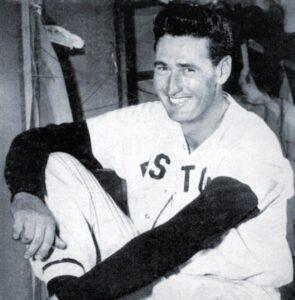 Ted “The Splendid Splinter” Williams … Ted Williams’ nickname (one of several) – the Splendid Splinter – reflects his lanky, splinter-like build and his splendid skills. Notably, Williams’ play earned him a team’s worth of nicknames – The Kid, Teddy Ballgame and The Thumper among them. Williams’ career on-base percentage of .482 is the best in baseball history (among players with at least 3,000 plate appearances). Williams was a 19-time All Star, two-time MVP and two-time Triple Crown winner. In 19 seasons with the Red Sox (1939-60, time lost for service in WWII and the Korean Conflict), Williams won six batting titles, and lead the AL in runs six times, RBI four times, home runs four times, doubles twice, walks eight times and total bases six times. He retired with a .344-521-1,839 stat line.
Ted “The Splendid Splinter” Williams … Ted Williams’ nickname (one of several) – the Splendid Splinter – reflects his lanky, splinter-like build and his splendid skills. Notably, Williams’ play earned him a team’s worth of nicknames – The Kid, Teddy Ballgame and The Thumper among them. Williams’ career on-base percentage of .482 is the best in baseball history (among players with at least 3,000 plate appearances). Williams was a 19-time All Star, two-time MVP and two-time Triple Crown winner. In 19 seasons with the Red Sox (1939-60, time lost for service in WWII and the Korean Conflict), Williams won six batting titles, and lead the AL in runs six times, RBI four times, home runs four times, doubles twice, walks eight times and total bases six times. He retired with a .344-521-1,839 stat line.
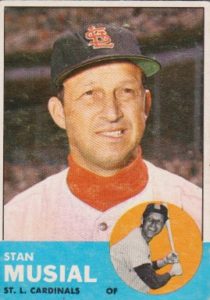 Stan “The Man” Musial … Hall of Famer Musial (who started more than 1,800 of his 3,026 games played in the outfield – and started more games in left field – 868 (than in RF or CF – 679 and 306, respectively) was indeed “The Man” – and not just in Saint Louis (where he played from 1941-63). He was respected for his bat and his attitude around baseball. Musial was a seven-time batting champ and three-time MVP, who also led the NL in hits six times, runs scored five-times, doubles eight times, triples five times and RBI twice. He retired with a .331 average, 3,630 hits, 475 home runs, 1,949 runs scored and 1,951 RBI.
Stan “The Man” Musial … Hall of Famer Musial (who started more than 1,800 of his 3,026 games played in the outfield – and started more games in left field – 868 (than in RF or CF – 679 and 306, respectively) was indeed “The Man” – and not just in Saint Louis (where he played from 1941-63). He was respected for his bat and his attitude around baseball. Musial was a seven-time batting champ and three-time MVP, who also led the NL in hits six times, runs scored five-times, doubles eight times, triples five times and RBI twice. He retired with a .331 average, 3,630 hits, 475 home runs, 1,949 runs scored and 1,951 RBI.
CENTER FIELD
 James “Cool Papa” Bell … Ask fans who James Bell was and very few will give you a confident answer. Ask about Cool Papa Bell, you’ll not only get name recognition, but probably a couple of apocryphal stories about Bell’s blinding speed. (Like Satchel Paige’s tale that “Once, he (Bell) hit a line drive right past my ear. I turned around and saw the ball hit his a** sliding into second base.”
James “Cool Papa” Bell … Ask fans who James Bell was and very few will give you a confident answer. Ask about Cool Papa Bell, you’ll not only get name recognition, but probably a couple of apocryphal stories about Bell’s blinding speed. (Like Satchel Paige’s tale that “Once, he (Bell) hit a line drive right past my ear. I turned around and saw the ball hit his a** sliding into second base.”
Bell got the nickname, when he was a rookie pitcher (1922) with the St. Louis Stars of the Negro National League. Early the season, the 190-year-old Bell was facing the legendary Oscar Charleston in a tight spot in a close game and “cooly” struck him out. St. Louis manager Bill Gatewood commented on just how “cool” Bell was under pressure and later added “Papa” to the nickname to make it sound better. It stuck with Bell, elected to the Hall of Fame in 1974, throughout his career. Bell, considered by most to be the fastest player ever to take the field, played in 21 seasons (1922-37, 1942-46 … St, Louis Stars, Chicago American Giants, Detroit Wolves, Homestead Grays, Pittsburgh Crawfords). He hit .296-57-596 in 1,202 games. A seven-time All Star, Bell led his league in run scored five times and stolen bases seven times, A superior defender he led his leagues’ CF in put outs four times, assists three times, double plays twice and fielding percentage three times.
Reserve: Jimmy “The Toy Cannon Wynn … Jimmy Wynn was just 5”10” and 160 points and earned his nickname for the power he generated for his size. Lots of points for appropriateness here. Wynn played 15 MLB seasons (1963-77), primarily with the Astros., The three-time All Star hit .250-291-964, with 1,105 runs scored and 225 steals. He hit 30+ home runs in three seasons and had another five seasons of 20 or more long balls. His best season was probably 1974, when he hit .271, with 32 homers, 108 RBI, 104 runs scored and 18 stolen bases.
I also considered Franklin “Death to Flying Things” Gutierrez, Joe “The Yankee Clipper” DiMaggio and Sam “The Jet” Jethroe. Competitions in CF was indeed tough.
RIGHT FIELD
Dave “Cobra” Parker … Dave Parker’s Cobra nickname was born out of his bat speed – striking with the quickness of a Cobra. Parker brought fame to the nickname over 19 seasons (1973-91 … Pirates, Reds, A’s, Brewers, Angels, Blue Jays). The seven-time All Star hit.290-339-1,493 in 2,466 MLB games. Parker, who was the 1978 NL MVP, also has two batting titles and three Gold Gloves on his MLB resume. He also led his league in hits once, doubles twice, RBI once and total bases three times.
Dave “Cobra” Parker made his final All Star Team in 1990 – at the age of 39 – when he went .289-21-92 for the Brewers.
Reserve: Jose “Joey Bats” Bautista … Jose Bautista played 15 MLB seasons (2004-2018 … Orioles, Devil Rays, Royals, Pirates, Blue Jays, Braves, Mets, Philllies). He picked up the nickname Joey Bats while with the Pirates. Reportedly, a PNC vendor made a sign that read “Joey Bats” and raised it whenever Bautista came to the plate. Once the broadcast crew (and television cameras) discovered the sign, the nickname began to take on life. The nickname rose to prominence during Bautista’s years in Toronto, where he was an All Star in six of ten seasons. Bautista hit .247-344-975 over 1,798 MLB games. He twice led the AL in home runs, with a high of 54 in 2010 For The RoundTable, Joey Bats just seems like a nickname that is both fun and appropriate for a power hitter.
DESIGNATED HITTER
David “Big Papi” Ortiz … As David Ortiz explains it, his nickname started with the fact that he was not great at remembering names – and (as a big league ballplayer) was constantly meeting a lot of people. So, he began calling them Papi (as is the custom in the Dominican Republic). People started calling him Papi back. Eventually, given Ortiz’size, big heart and the large leadership role in played in the Red Sox’ success, he became Big Papi. He’s in this lineup because of the love for Ortiz – and his nickname – among Red Sox’ fans. The fact is, mention Big Papi to the average fan and they immediately know who you are talking about.
Ortiz played 20 MLB seasons (1997-2016 … Twins and Red Sox). He put up a .286-541-1,768 stat line. The Hall of Famer was a ten-time All Star, hit 30 or more homers in ten seasons add drove in 100 or more runs in ten seasons.
In his final season (2016), at age 40, David Ortiz hit .315, with 48 home runs and 127 RBI.
THE ROTATION
“Sudden” Sam McDowell … Yes, there are some Hall of Fame Pitchers with great nicknames. Walter “Big Train” Johnson, “Rapid Robert” Feller are just two. However, that “Sudden” nickname is my favorite. McDowell – whose blazing heater could be past you with amazing suddenness – was a six-time All Star and five-time league strikeout leader. In a 15-year MLB career (1961-75 … Indians, Giants, Yankees and Pirates), McDowell went 141-134, 3.17 and fanned 2,453 hitters in 2,492 1/3 innings. I like the simplicity of this nickname,
Leroy “Satchel” Paige … Lots of points for usage. Say the name “Satchel” and The vast majority of baseball fans will know almost immediately who you are referring to. Satchel Page is what legends are made of. No less than Joe DiMaggio, Ted Williams and Bob Feller all called him the best pitcher they ever saw. The story behind the nickname also gets some points, As a youngster, Leroy Paige carried luggage (satchels) for train passenger in a railroad stations. The nickname stuck.
Paige pitched in 22 MLB seasons (1927-31, 1933-34, 1936, 1940-49, 1951-53, 1965 – taking the mound for the Birmingham Black Barons. Pittsburgh Crawfords, Kansas City Monarchs, New York Black Yankees, Memphis Red Sox, Cleveland Indians, St, Louis Browns and Kansas City Athletics). His MLB record was 124-82, 2.73. He was a seven-time All Star who led his league in wins once, winning percentage three times, ERA once, shutouts three times and strikeouts six times. He was also one of – if not the biggest draw in the Negro Leagues and on the barnstorming circuit.
Randy “The Big Unit” Johnson … Some of the most popular pitchers nicknames are derived from the speed of their pitchers – think Dick “Cannonball” Redding , Roger “The Rocket” Clemens, “Rapid” Robert Feller, I tended to gravitate for those that fell outside that parameter – at least at the top of the rotation. So here at three is 6’ 10” flamethrower Randy “The Big Unit” Johnson. Simple, to the point and worthy of Johnson intimidating presence.
The Hall of Famer pitched 22 years in the big leagues (1988-2009), going 303-166, 3.29 and fanning 4,875 batters in 4,135 1/3 innings (and leading the league in whiffs nine times). The five-time Cy Young Award winner also led the league in wins once, ERA four times, complete games three times.
From 1999 through 2002, Randy Johnson’s average season was 20-7, 2.48 – with 354 strikeouts (12.4 per nine innings).
Wilber “ Bullet” or “Bullet Joe” Rogan … Like Satchel Paige, Joe Rogan’s nickname has replaced his given name (and middle name) in most accounts. He is most often referred to simply as Bullet Rogan . Now that is nickname recognition. At just 5’7” and 170 pounds, Bullet Rogan Bullet Rogan did , indeed, throw bullets – and he complemented his sidearm fastball with an exceptional curve.
Rogan Played in the Negro Leagues for 12 seasons (1920-29 and 1937-38), all for the Kansas City Monarchs. He went 120-52, 2.65 over that time – leading the league in wins twice, ERA once, complete games three times, shutouts twice and strikeouts twice. Oh, and Bullet Rogan could put his 50-ounce bat on the ball, compiling career average of .338,while spending considerable time in the outfield.
“Jughandle” Johnny Morrison … Johnny Morrison earned the nickname Jughandle for a sharp breaking ball that curved and dropped like the handle on the side of a jug. Morrison pitched in ten MLB seasons (1920-27, 1929-30 … Pirates, Dodgers), going 103-80, 3.65. His best season was 1923, when he went 25-13, 3.49 for the Pirates.
Reserve: Vic “The Springfield Rifle” Raschi was another of those hard throwers who could rifle the ball up to the plate. Extra points among flamethrowers here for a nickname that incorporates his home town of West Springfield Massachusetts and the nearby Springfield Armory firearms manufacturing company.
Raschi pitched in ten MLB seasons (1946-55), primarily for the Yankees. He went 132-66, 3.72, was a four-time All Star and a three-time 20+ game winner. Between 1948 and 1952, he went 98-42, 3.45 for the Yankees, completing 51 percent of his 165 starts.
CLOSER
 Al “The Mad Hungarian” Hrabosky … Al Hrabosky’s nickname is drawn from his ethnicity and his ferocious mound demeanor. With his long hair and Fu Manchu mustache (later a full beard), Hrabosky would turn his back to the batter, talk angrily to the ball, pound the ball the into his glove, then turn and storm to the rubber glaring menacingly at the batter. That aggressive persona, Hrabosky maintained, was an asset on the mound.
Al “The Mad Hungarian” Hrabosky … Al Hrabosky’s nickname is drawn from his ethnicity and his ferocious mound demeanor. With his long hair and Fu Manchu mustache (later a full beard), Hrabosky would turn his back to the batter, talk angrily to the ball, pound the ball the into his glove, then turn and storm to the rubber glaring menacingly at the batter. That aggressive persona, Hrabosky maintained, was an asset on the mound.
Hrabosky pitched in 13 MLB seasons (1970-82 … Cardinals. Braves, Royals), going 64-35, 3.10 with 97 saves. He had just one start in 545 appearances. Consider one of the top closers of his time (actually, I think they were thought of more as firemen than closers), in 1975 Hrabosky went 13-3, 1.66, with a league-topping 22 saves for the Cardinals.
In a 1975 Sport Illustrated Interview, AL Hrabosky was quoted as saying “I want batters to think I’m crazy. I want them to know I’m crazy.”
Reserve Tie: Mariano “The Sandman” Rivera … Mariano Rivera is, arguably, the best closer in MLB history – his MLB-record 652 saves attest to that. His nickname came about when a Yankees’ technician suggested Metallica’s heavy metal “Enter Sandman” as Rivera’s entry song. It was certainly appropriate, as Rivera’s “cutter” put opposing batters (and any hopes of rallying) to sleep, The tune was embraced by Rivera, his teammates and fans. Rivera pitched 19 MLB seasons (1995-2013) all as a Yankee. He was a 13-time All Star, led the AL in saves three times. Rivera had two seasons of 50 or more saves, seven seasons of between 40 and 45 saves and six season of between 30 and 39 saves. He also recorded 11 seasons with an ERA under 2.00 – and his ERA in 96 post-season games (141 innings) was a miserly Sandman-like) 0.70.
Reserve: Dick “The Monster’ Radatz … Dick Radatz, at 6’6” and (conservatively) 230-pounds, was a big man for his time – and an imposing presence on the mound. Radatz also put up some monster seasons early in his career. In fact, a look at his numbers will show how times have changed. Consider his two All-Star seasons (with the Red Sox) – 1963 and 64:
- In 1963 Radatz made 66 relief appearances, finishing 58 games; averaged just over two inning per appearance; put up a 1.97 ERA; won 15 games (six losses); and notched 23 saves.
- In 1964, he made 79 appearances; finished 67 games; averaged 1.99 innings per appearance; put up a 2.29 ERA; won 16 games (nine losses): and saved a league-best 29.
Radatz played in seven MLB seasons (1962-67, 1969 … Red Sox, Indians, Cubs, Tigers , Expos). He went 52-43, 3.13, with 120 saves.
Nicknames Extra .., Some Names are Just Wonderful On their Own
Okay, this is not a nickname and this player didn’t make the major leagues, but it deserve recognition here. I’m talking about former Braves’ minor-league outfielder Wonderful Terrific Monds, III. (Yes, that’s his given name.) Monds was signed by the Braves in the 50th round of the 1993 draft (out of Tennessee State University). Monds played in seven minor-league seasons, hitting .281-55-243, with 162 steals. (Side note: His father, Wonderful Terrific Monds, Jr. played one season – 1978 – for the NFL San Francisco 49ers.)
The story has it that Monds’ great grandfather longed for a son, but his marriage produced 11 daughters before a son was born. Reportedly, he declared finally having a son wonderful and terrific and it became a family tradition to name the first boy in each generation “Wonderful Terrific Monds.” Wouldn’t it have been wonderfully terrific if he had made the show.
Regardless, this seems a wonderfully terrific way to end this post.
Primary Resources: Baseball Reference.com; Having Fun with Baseball Nicknames, by Phil Blazovich, MLC Publications 1996; The Baseball 100, by Joe Posnanski, Avid Reader Press, 2021; Ted “Double Duty” Radcliffe, The History Makers.org, June 16, 2001.
Baseball Roundtable – Blogging Baseball Since 2012.

 Baseball Roundtable is on the Feedspot list of the Top 100 Baseball Blogs. To see the full list, click here.
Baseball Roundtable is on the Feedspot list of the Top 100 Baseball Blogs. To see the full list, click here.
Baseball Roundtable is also on the Anytime Baseball Supply Top 66 Baseball Sites list. For the full list, click here.
I tweet (on X) baseball @DavidBaseballRT
Follow Baseball Roundtable’s Facebook Page here. Find More baseball commentary; blog post notifications; PRIZES.
Member: Society for American Baseball Research (SABR); Negro Leagues Baseball Museum; The Baseball Reliquary.


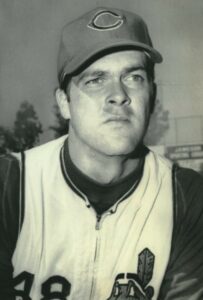

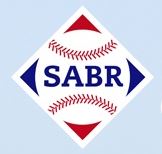

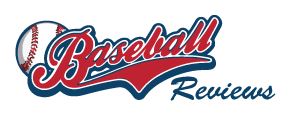



Maybe they were in the article and I missed them, but Bob “Death to Flying Things” Ferguson and Buttercup Dickerson deserve mention.
No Starvin Marvin? No Baby Doll?